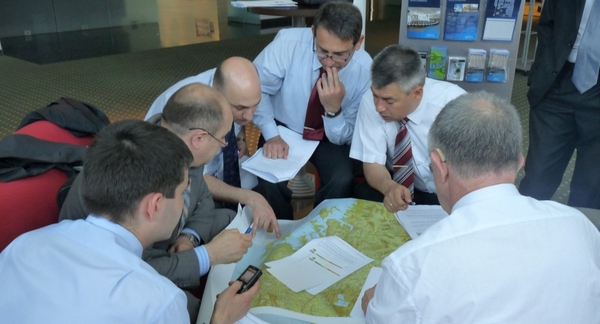Differentiation of state property in the Russian Federation is carried out in accordance with a number of provisions of the Constitution, Federal Law of sectoral significance. At the same time, presidential decrees, government decisions, as well as rules, orders, regulations, instructions and other acts adopted by executive bodies have a certain impact on this area. Next, we consider in more detail what constitutes the delineation of state ownership of land. 
Constitutional provisions
The concept of state ownership of land, as well as the rules for its circulation are established in a number of provisions of the Basic Law. These include, in particular:
- Art. 72, paragraph 1, subpara. "g". It says that the delineation of state property is under the general jurisdiction of the country and its subjects. In accordance with this, bills are issued and other normative acts are adopted on their basis. Moreover, the latter should not be in conflict with the Federal Law. In case of non-compliance, Art. 76 of the Constitution.
- Art. 35, paragraph 3. His provisions indicate the impossibility of depriving anyone of his property, except by a court decision. Forced alienation in favor of the state is allowed subject to certain conditions. In particular, an equivalent and provisional refund should be provided. With regard to the topic under discussion, the right of state ownership of land should not infringe on the interests of legal entities and citizens - owners of allotments.
Industry legislation
The main regulatory act in this area is the Civil Code. It regulates the grounds in accordance with which obligations and opportunities appear, the legal status of individuals and public entities, provides a definition of immovable objects. In addition, the Civil Code establishes the rules for state registration, regulates the right of ownership. It contains other norms that are relevant in the area under consideration. 
The procedure for delimiting state property: general information
It provides for the work of a fairly significant amount. Within the framework of the topic under discussion, it includes land management measures, as well as cadastral state registration of plots. These works are regulated by Federal Law No. 28 and No. 78.
When determining the state plots of land, the grounds for entering them into the corresponding list, other laws should also be taken into account. This, in particular, Federal Law No. 40, No. 79, No. 126. In them, in one form or another, federal ownership of land was proclaimed. It should be borne in mind that if there are contradictions between the Federal Laws adopted earlier and the Constitution, the provisions of the latter will take precedence. The main support for interactions within the scope of this sphere is carried out by the provisions contained in the Land Code of the Russian Federation. Of particular importance in it are the norms for the categories of allotments and their composition.
The subject of state ownership of land
As it can act:
- Municipality.
- Russian Federation.
- Separate region.
The norms apply to these categories, according to which the participation of organizations (legal entities) in relations regulated by the Civil Code is determined, unless otherwise follows from the law or the characteristics of these entities. The main requirements are contained in Art. 125. According to it, on behalf of the constituent entities and the Russian Federation itself, through their actions they can exercise and acquire personal non-property and property obligations and rights, as well as speak at court hearings by state authorities within their competence. It is established by acts that determine the legal status of these institutions.
On behalf of the municipality, territorial self-government bodies can acquire and exercise civil duties and rights within their competence. It is also determined by the relevant acts establishing their legal status. The first category of subjects of law for which the presence of land plots is the basis for classifying them as belonging to the Russian Federation are state and territorial authorities. The second group includes unitary enterprises, municipal institutions, as well as other non-profit organizations. The latter should be formed by the state authorities of the Russian Federation. 
check in
According to Art. 2, paragraph 1 of the Law, unrestricted state ownership of land ceases to be such after its registration in accordance with the law. Under it, in particular, is meant primarily the Civil Code. Also, general provisions are provided for in the Federal Law governing the state registration of the right to real estate and transactions with it. Prescriptions are also contained in normative acts adopted on its basis.
Legal implications
They arise immediately after the state ownership of the land of the municipality, the Russian Federation or its regions is established. Legal consequences are of particular importance in the system of regulation of relations in this area. So, the Land Code of the Russian Federation determines that each public entity manages and disposes only those allotments that belong to it by law. This is spelled out in Art. 29, Art. 11, paragraph 2, Article 10, paragraph 2, Article 9, p. 2.
In addition, state ownership of land implies the possibility of public education to determine the amount of rent, the rules, terms and conditions of its payment. This also applies only to those allotments for which there is legal justification. 
Documents
The state form of land ownership, as well as the private one, must be registered. This must be confirmed by relevant documents. Their approximate list is defined in Art. 17 Federal Law governing state registration of rights to real estate and transactions with it. In addition, the list of documents is largely based on Art. 8 GK. She, in turn, establishes the basis for the emergence of civil duties and rights.
Lists
They act as the main category in the above law governing the registration and delineation of state ownership of land. Lists are prepared by authorized executive (federal) bodies. Further, they are coordinated by the relevant units of state, municipal and regional authorities. After that they are approved by the Government. Having gone through all these stages of approval and approval, the lists become the grounds in accordance with which state lands are registered. Articles 3-5 of the Law contain justifications for listing allotments. In fact, these provisions define the criteria by which the distinction is made between state ownership of land. 
Categories and Subcategories
They are the basis of the system of criteria by which state lands belong to a particular group. They are conditionally classified as follows:
- Subcategories and categories of lands in which allotments are assigned exclusively to the property of any public entity or group thereof.That is, the area belongs either to a municipal formation, or to the Russian Federation, or to a region.
- Subcategories and categories of lands in which allotments can be attributed exclusively to the property of various public entities on the basis of the conditions defined by the Law. This position is regulated by Art. 3 paragraph 3, 4; Art. 4, paragraph 1, para. 3, 5; Art. 5, paragraph 1, para. 3, 4.
Art. 3 of the Law establishes the grounds for making allotments in the lists of land plots in respect of which the right of ownership of the Russian Federation is formed.
Classification
In paragraph 2 of Art. 3 of the Law provides for four subcategories and categories of land, the plots in which should be classified as state property. These include, in particular:
- Forest Fund.
- Earth security and defense.
- Specially protected natural areas.
- A water fund occupied by facilities on which federal property is established.
In Art. 3, para. 3, 4, five subcategories and categories are highlighted. To them, in particular, include land:
- Industry, energy, space support and computer science, television, communications, broadcasting, transport and so on.
- Agricultural purpose.
- Water fund and stock.
- Historical, cultural, recreational and environmental significance.
- Settlements.
In the list of varieties of real estate, which is provided by law, special significance from the point of view of the Law in question is given to structures and buildings. The ownership right to them, which the Russian Federation has, acts as the basis for listing the relevant places on the lists of those that belong to the Russian Federation. The rules for making such allotments in the lists are established in Art. 3, para. 3. According to him, the inclusion of a land plot in the list is carried out on the basis of confirmation of the location of this property in the ownership of the Russian Federation.
Unitary enterprises
This category of subjects of law should be understood as the type of legal entities - organizations of a commercial type. This definition is established in the Civil Code. The unitary enterprise form can only be used for municipal and state institutions. Such commercial organizations, according to Art. 113-115 Civil Code, have at their disposal certain property, which is assigned to them. Moreover, they do not have ownership rights to it.
The content of Art. 3
Within the meaning of paragraph 3, only the decision to grant it to the state, territorial authority, as well as to a unitary enterprise, institution and any other non-profit organization can serve as the basis for including the respective land allotments in the lists of land plots on which the Russian Federation acquires ownership rights created by these institutions. This provision was adopted on June 12, 1990 and is valid to the present.
In paragraph 4 there is another category of land. It includes the territory of the reserve. The plots in them may relate to state property in accordance with certain conditions. In particular, they include:
- Being on these allotments of real estate belonging to the Russian Federation.
- The presence of privatized real estate, which was previously owned by the state.
As art. 103 ЗК, the territories of the reserve include allotments that belong to the Russian Federation and are not provided to organizations and citizens for use. The exception is the territory of the redistribution fund. It is formed according to Art. 80 of the Land Code. 
The essence of article 4
It establishes the grounds for including allotments in the lists of categories that pass into the possession of the Russian Federation after the distinction has been made between state ownership of land. In this article, in contrast to para. 2 tbsp. 3, provides for three subcategories and categories of territories.Allotments included in their composition should be attributed to the ownership of the country's regions. This group includes land:
- Natural areas under special protection.
- Water Fund, which are the property of the regions of the country.
- Reallocation fund.
Explanations to Article 5
In its provisions, the grounds are established in accordance with which the territories are included in the lists of land plots in respect of which the ownership of municipalities arises. In paragraph 2, paragraph 1, only two subcategories and categories of allotments are provided, the parts of which, of course, must belong to public groups. These include land:
- Territories of municipal importance, under special protection.
- Water fund on which are located water bodies Related to the ownership of local authorities.
Finally
Any long and complex legal, political and economic processes, to which, undoubtedly, the differentiation of land ownership, cannot take place completely without conflict. The emergence of a variety of disputes and conflicts between participants in the interactions within the framework of this sphere is facilitated by the shortcomings of the legislative framework, the diversity of overlapping interests of public entities, and the objective novelty of the problems. Assuming the occurrence of conflicts, in Article 7, the legislator identified the main methods for resolving them. In particular, this is the application of conciliation procedures and appeal to the courts.
